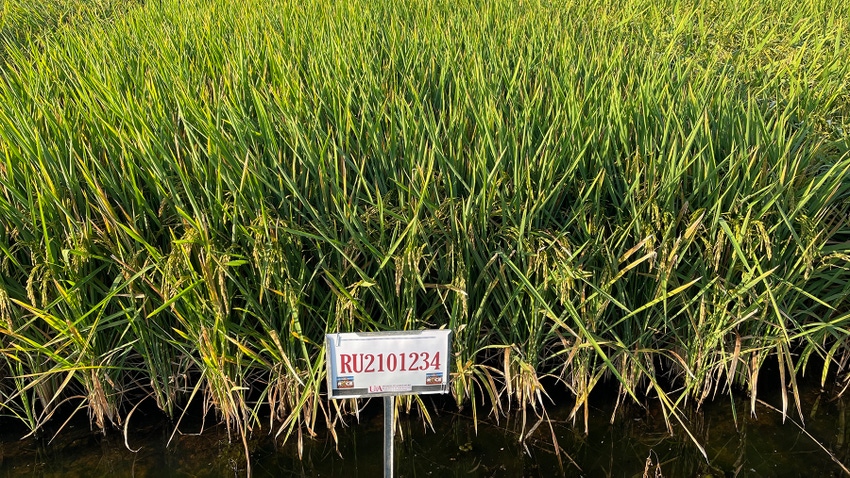May 12, 2023

At a Glance
- Arkansas Agricultural Experiment Station releases high-yielding Clearfield rice variety.
- CLM05 yielded 192 bushels per acre in statewide and regional trials.
- Seed will be available from BASF Agricultural Solutions through Horizon Ag in 2025.
By Brittaney Mann, U of A System Division of Agriculture
The Arkansas Agricultural Experiment Station has released a new high-yielding medium-grain Clearfield rice cultivar at a time of elevated U.S. demand for medium-grain rice.
The new rice variety is called CLM05, and it averaged 192 bushels per acre over two years in statewide trials. It outperformed current commercial cultivars CLM04 and Jupiter in grain yield, disease resistance and lodging resistance, said Xueyan Sha, professor of rice breeding and genetics for the experiment station, the research arm of the University of Arkansas System Division of Agriculture.
During the 2022 rice season, the state average yield was 164.7 bushels per acre, according to the 2023 Arkansas Rice Quick Facts, published by the Division of Agriculture’s Cooperative Extension Service.

Xuyan Sha, University of Arkansas System Division of Agriculture rice breeder at the Rice Research and Extension Center, Stuttgart. (Fred Miller, U of A System Division of Agriculture)
Medium-grain rice typically makes up 10 to 15% of the state’s rice acreage, Sha said. It is primarily used by companies like Kellogg’s and General Mills for snacks and table rice. It is also exported to Southeast Asia — especially Taiwan and Turkey.
“This is going to be a replacement showing lots of promise,” Sha said.
Limited availability
The Division of Agriculture is producing foundation seed of the variety this year, and a limited amount of seed will be available next year, said John Carlin, director of the division’s Arkansas Crop Variety Improvement Program. Horizon Ag will increase seed production, and it should be widely available in 2025.
“We’re hopeful that it’ll give Mid-South producers a solid yielding medium-grain variety that they can use in a weed-controlled program with the Clearfield Production System,” Carlin said.
“CLM05 has a similar disease package, but it outyields CLM04 by quite a bit,” Carlin said. “So with the increased demand in medium-grain due to California’s water issues, it has a really good fit in the Mid-South market.”
California typically accounts for around 75% of U.S. medium- and short-grain rice acreage, according to the United States Department of Agriculture’s October 2022 Rice Outlook. But because of a “severe and prolonged drought, low reservoir levels and water restrictions,” California’s total rice harvested area is the smallest it has been since 1958 to 1959, the report said. According to the final rice harvested acreage numbers released by the USDA, California rice production fell to 254,000 acres — a 37% decrease from the rice harvested area in 2021.
Sha said he is hopeful that this variety will offer a higher-yielding medium-grain variety for Mid-South growers.
Product of a partnership
“We are very pleased with the introduction of CLM05 to the Clearfield medium-grain rice varieties that are marketed by Horizon Ag and their approved retailers,” said Frank Hardimon, Rice Licensing Account Manager for BASF Agricultural Solutions. “CLM05 has performed very well in university and pre-commercial trials. It will help fill a growing demand for high-quality, medium-grain rice varieties in 2025 for Arkansas rice growers, as well as rice growers throughout the Mid-South.”
Tim Walker, Horizon Ag general manager, also expressed confidence in the variety’s ability to help meet medium-grain demands.
“Horizon Ag is very excited to bring CLM05, a next-generation medium-grain rice, to our farmer customers,” Walker said. “With each new variety, Horizon continues to raise the bar for yield potential. In pre-commercial trials in Arkansas and Louisiana, CLM05 yielded with our best-in-class Clearfield varieties like CLL16 and CLL18. Just as important, in medium-grain acres where conventional varieties have been dominant, the Clearfield system brings tremendous value in grass and red rice control.”
Walker noted that the release of CLM05 illustrates how the partnership of Horizon Ag with university breeding programs benefits rice farmers throughout the South. “We are facilitating rather than competing with university breeders, helping bring superior varieties like CLM05 to their fields,” he added.
“Dr. Sha’s reputation for breeding medium-grain varieties that meet the demands of buyers like Kellogg’s and others is another key benefit of growing CLM05,” Walker said. “There is an advantage when farmers have access to a superior yielding product that’s also desirable to the market. There will be a lot of interest in CLM05 when it is available.”
CLM05 characteristics
CLM05 is susceptible to the rice diseases sheath blight and leaf blast, Sha said. It is moderately susceptible to neck blast, bacterial panicle blight and false smut.
Sha also noted that the new variety is moderately resistant to narrow brown leaf spot, a disease that has intensified in the last two to three years.
These diseases are major causes of yield loss and lower profits for Arkansas rice farms, according to the extension service’s “Rice Production Handbook.”
Maturity days to 50% heading is 90 days, which is similar to other varieties, Sha said.
The plant’s height averaged about 35 inches during testing, Sha said. It is about 2 inches taller than Jupiter but 3 inches shorter than CLM04, and it has improved lodging resistance over both cultivars.
The milling yield for CLM05 is 61% head rice to 67% total rice, Sha said. Milling yield represents the percentage of edible rice obtained from milling the “raw” rice harvested from the field. The milling process removes the outer layers of harvested rice to reveal edible kernels. Milling yield includes percent “head rice” — kernels that are over two-thirds the whole length after milling — and the total percent of whole and broken kernels obtained from milling.
The milling yield may be slightly lower than CLM04, which had a milling rate of 64% head rice to 69% total rice, Sha said. The standard milling yield is at least 55% head rice in Arkansas.
Sha said that CLM05 was developed with support from the Arkansas Rice Research and Promotion Board and BASF.
Breeder seed for CLM05 will be maintained at the Division of Agriculture’s Rice Research and Extension Center in Stuttgart and distributed to growers by Horizon Ag, a seed technology company licensed by BASF to market Clearfield rice varieties.
Source: University of Arkansas System Division of Agriculture
You May Also Like




